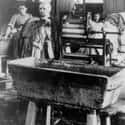-
(#6) The Church Still Largely Denies What Happened
In 2011, the United Nations Committee Against Torture launched a lengthy investigation into the laundries and found that their "management teams" had indeed likely been guilty of exploitation and abuse.
Nevertheless, while some religious orders did offer up condolences for past evils, many of the culpable organizations have refused to acknowledge that said brutalities ever took place. Moreover, officials from the group JFM (Justice for Magdalenes) aren't convinced that even the apologetic sentiments were sincere, claiming that:
"Rather than apologies, they used phrases such as 'it was regrettable that the Magdalene homes had to exist at all' and claimed the laundries were 'part of the system and culture of the time.'"
Ah, "the culture of the time." Such a get-out-of-laundry-free card, whether the issue at hand is routine lobotomies, medieval torture devices, or just run-of-the-mill witch burning.
-
(#4) Thousands Of Women Died Of "Negligent Homicide"
Many of the deaths that occurred at Irish laundries (which mostly came about through medical negligence) were not reported, according to sources citing 2013's groundbreaking McAleese Report. Though the asylums officially recorded 879 deaths, a group called "Justice for Magdalenes" interviewed survivors and "collected testimonies about death and burials, gravestones, electoral registers, exhumation orders, and newspaper archives." Eventually, from all of this research, they determined the number of un-reported deaths to be closer to 1,663... though this figure remains both controversial and denied by the powers that be.
-
(#7) Many Girls Tried To Run Away Or Escape
The Magdalene laundries were not without their courageous heroines. Numerous inmates tried to escape or run away, and some even made it out to a better life. One survivor, Elizabeth Coppin, told Aljazeera that:
"One of the nuns came down and accused me of stealing someone's sweets. Two of the women dragged me up to a dark cell. I stayed [there] for three days and three nights, and... that was when I realized two things: no one was coming to help me, and what they were doing was wrong. I decided to run away. There were no bars on the windows at the front of the building, so me and another girl decided to jump out one of them when the nuns weren't looking. We ran into the city. We had nothing... but we were good workers, so we managed to get a job working in a hospital that trained nurses. I was 17 by then. We were happy."
However, things didn't end well for Coppin:
"One day a man came. He was from the Irish Society for the Prevention of Cruelty to Children... [he] brought me to another laundry. When he left, he said: 'you run away from this place and we'll put you someplace you'll never get out of.'"
Another girl, Mary Norris, was luckier: after she was committed to a laundry for taking "a forbidden night off" from her job as a servant, she spent two years in hell before her aunt finally tracked her down and negotiated her release.
-
(#8) Survivors Are Still Coming Forward
While many Magdalene survivors have already gone on record and become activists, many more are still coming out of the woodwork. One such individual was Margaret Bullen, who had reportedly been forced by nuns to give her three daughters up for adoption; two of them finally tracked her down in 1995. At that time, Bullen was still institutionalized as she had been for most of her life. According to one daughter's account in The Telegraph:
"Margaret [spent] her childhood and puberty in these institutions, without the chance to grow up. At age 16, she was transferred to the Gloucester Street Magdalene Laundry... there she toiled, unpaid for the rest of her life."
Eventually, Margaret was entrusted to the care of the Irish state, who promptly sub-contracted that duty back to the Catholic Church.
Margaret Bullen, who had blocked out many of her traumatic experiences, claimed to have no memory of having given birth at all, though she did manage to enjoy a relationship with her daughters for a couple of years. She died in her 40s of end-stage kidney and liver failure brought on by the chemicals she'd inhaled while working in the laundries.
-
(#2) They Operated For 231 Years & Only Closed In 1996
The sordid history of laundries is an extraordinarily long one; the first Irish institution, founded by philanthropist Lady Arabella Denny, opened in 1765. Known as Magdalene Asylums (after the "redeemed" Biblical prostitute Mary Magdalene), the homes purported to be sanctuaries for "fallen" women... i.e., unwed mothers, abused girls, girls who had been cast out by their families, and your run-of-the-mill freethinking feminists who were too eccentric, original, and "troublesome" to fit into the strictures of their communities.
Incredibly, the laundries continued to operate, in various stages of utilitarian bleakness (at best) and cruelty (at worst) until 1996. It's been estimated that over 30,000 women passed through the asylums, some staying a month and some remaining for a lifetime. Even that seems to be a conservative figure, though, when you consider that the time period in question spans over two centuries.
-
(#3) Mass Graves Were Discovered On Convent Grounds
In 1993, a mass grave was found on land owned by the Sisters of Our Lady of Charity of Refuge in Dublin. Inside were the remains of hundreds of "penitents" who had once been inmates at High Park, the largest laundry in Ireland. The final body count was 155.
All the corpses were cremated and reinterred in a different cemetery, but most of the deaths had not even been officially logged or certified, so it wasn't possible to notify relatives or provide closure of any kind. The general consensus, though, was that the bodies represented women or girls who had been neglected to death, mistreated to death, or some combination of both.
New Random Displays Display All By Ranking
About This Tool
The laundries operated by the church were not limited to Ireland in the 19 century, the history can be traced back to the Middle Ages in Europe. After centuries of operation, laundries were common all over Europe. By the end of the 19th century, there were at least 40 laundry rooms in Ireland that provided shelter for women who were thought to be on the streets, such as prostitutes or unmarried mothers.
However, the real-life behind these Irish laundries is not as kind and beautiful as people think. Most women entered laundries voluntarily at the beginning, and they wanted to learn knowledge and skills to make money. People didn’t know the miserable life of women in the laundries until the dark side was revealed. The random tool lists 12 details about brutal Irish laundries tortured women.
Our data comes from Ranker, If you want to participate in the ranking of items displayed on this page, please click here.
















